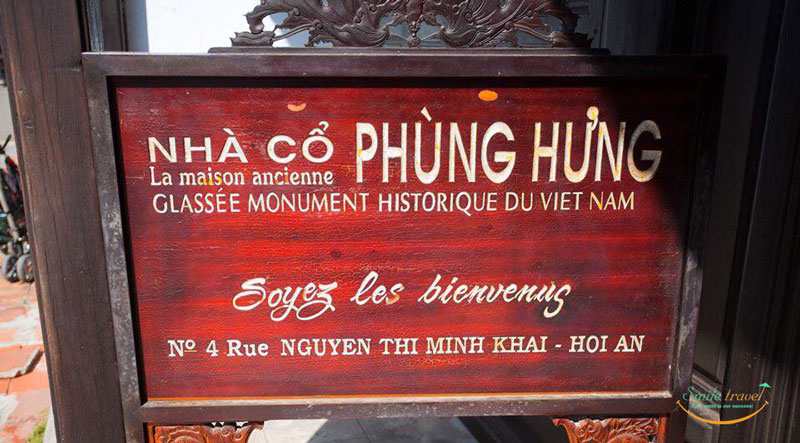
- On 18/11/2019
- In Travel Blog
- Tags: Cantonese Assembly Hall, Hoian, Hoian Folkore Museum, Hoian Museum of Ceramics, Hoian-Vietnam, Must-See in Hoian, Old House of Tam Ky Hoian Museum of History & Culture, Phuc Kien Assembly Hall, Phung Hung Ancient House, Tours in Hoian, Tran's Family Chapel, What to see in Hoian
A list of 8 Attractive Must- See in Hoian Ancient Town
A LIST OF 8 ATTRACTIVE MUST-SEE IN HOI AN ANCIENT TOWN
- Phung Hung Ancient House
- Cantonese Assembly Hall
- Tran’s Family Chapel
- Hoian Museum of Ceramics
- Phuc Kien Assembly Hall
- Old House of Tam Ky
- Hoian Museum of History & Culture
- Hoian Folkore Museum
—————————————-
-
Phung Hung Ancient House
- Opening Hours: Mon to Sun: 08.30 am- 6. Pm
- Admission Fee
- Good for: Culture, Family, History, Local Flavour
- Add: No 4 Nguyen Thi Minh Khai Street
The Old House of Phung Hung is one of the most famous architectural buildings in Hoi An, considered the cultural heritage of the town. Visit this ancient home in Hoi An and enjoy the old-world charm.
The architecture of Phung Hung house represents the combination of Vietnamese, Japanese and Chinese styles. There are a lot of designs carved by carpenters in the Kim Bong Village. The house used to be a shop trading in cinnamon, pepper, salt, silk, chinaware and glassware. Now part of the house is used as a workshop for making commercial embroideries.

Phung Hung Ancient House
The house is located at 4 Nguyen Thi Minh Khan Street. It was built in 1780 when Hoi An was prospering, and it is a typical commercial house representative of Vietnam’s urban areas in the 19th century. Conferred the title of “National Historical and Cultural Site” in 1993, the house has kept many documents about the architecture, culture, art and lifestyle of the Hoi An’s business circle from the old days. Phung Hung House bears the popular style of the 19th century – tubular shape, with a wide façade. It is not as long as some other old-style houses, and it is mainly made of wood, with two stories and four roofs. Here you can see a unique blending of two different architectural styles. The different floors are designed in two different styles: the Japanese style of four-sided roof can be perceived on the ground floor, and the Chinese design of round shaped roofs that reflect a turtle shell is present on the upper floor. The ground floor used to be the shop. Today, it is the family’s living room, furnished with some wooden old-style cupboards containing many precious objects and belongings. The house has 80 columns made of precious wood. Each column stands on a lotus-shaped base in order to minimize subsidence and moisture for the house and to prevent termites from damaging it. There are square pillars on the veranda, and the roof is made of pan-tiles.
A wide corridor made of wood surrounds the second story. On this floor, there is a square hole used for moving goods upstairs. The second floor is now reserved for the worship of the family’s ancestors and of Thien Hau Holy Mother. In the Old House, you will also find various handicrafts that reflect the culture and tradition of Vietnam. On the table, in front of the altar, there is always a bowl with seven marble dices, which the owner used in order to decide the departure time before his far-away journeys.
-
Cantonese “Contonnesse “ Assembly Hall, Hoi An, Vietnam
Cantonese Assembly Hall (built 1786 onward)
The Cantonese Assembly Hall (Hoi Quan Quang Trieu), founded in 1786, serves the Cantonese Chinese community of Hoi An. Its main altar is dedicated to Quan Cong. It is one of five assembly halls in Hoi An for different Chinese ethnic groups.
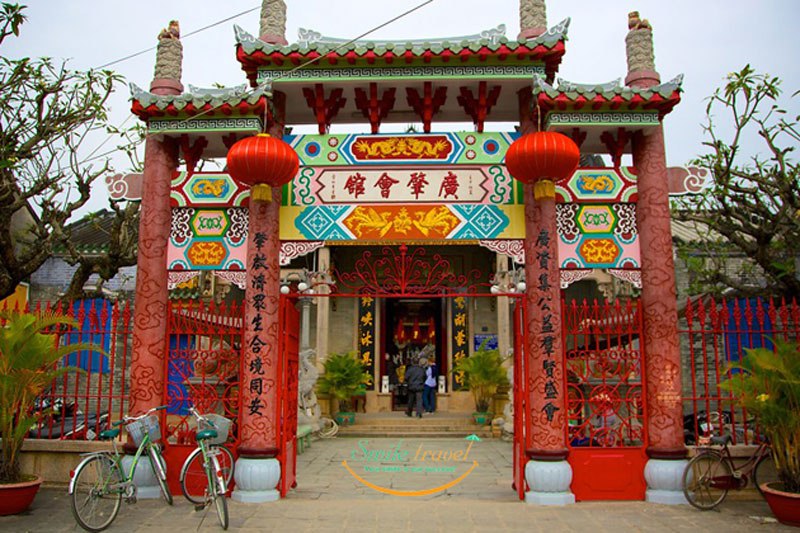
Cantonese Assembly Hall
The Quang Trieu (Cantonese) Assembly Hall, Hoi An is one of the most famous historical buildings in Hoi An, Vietnam. Besides having great historical significance, the hall is also a popular tourist attraction. You will be enchanted by this architectural heritage of Vietnam.
The house was built adjacent to Cau Pagoda on 176 Tran Phu Street, on the corner of Nhi Trung Street – a gastronomic street of Hoi An. It was built in 1885 by Chinese overseas who came from Guangdong/ Cantonese (China). In the early days, the house was dedicated to Thien Hau Holy Mother, then to Quan Cong, and then to the sages who came from Guangdong Formerly. It was a place for Chinese fishermen and traders to rest temporarily and to exchange goods. In those days, there was a wharf at the front of the house.
The complex of Quang Trieu Assembly Hall is rather attractive, with its stone three-entrance gate and four rows of stone pillars at the front. Four Chinese characters, meaning “Quang Trieu Assembly Hall”, are embossed on the upper part of the three-entrance gate. The gate is roofed with green tube-tiles and decorated with images of dragons, small lions, and lemon flowers. Stone pillars supporting the roof are carved with refined designs. The robust frame and decorative designs make the house look imposing
The Assembly Hall holds an amazing fountain that features a dragon. The dragon is a beautiful creation made out of pottery. Besides that, there are more attractions waiting for you inside the Quang Trieu (Cantonese) Assembly Hall in Hoi An. Various Cantonese statues are spread out all over the hall. Some of these statues reflect the musical dramas of the Cantonese culture. In the Assembly Hall, many ancient vestiges have been preserved – a four big horizontal lacquered boards, a big bronze censer, a pair of Chinese terra-cotta seats and noteworthy documents on the Chinese community living in Hoi An.
Records say this hall was built by the Chinese Cantonese merchants. The different parts of the building are separately made in China. After finishing the work, those parts were transferred here and joined together to build The Quang Trieu (Cantonese) Assembly Hall in Hoi An.
Every year, on the 15t of the first lunar month, the Nguyen lieu Festival is held here. Also, on the 24th of the sixth lunar month, the festival to pay homage to Quan Cong (a Chinese general) attracts many pilgrims. Outside the Quang Trieu (Cantonese) Assembly Hall, you will find various shops and markets. The main attractions to the tourists to silk dresses. So go ahead and buy some silk pajamas for yourself.
-
Tran’s Family Chapel
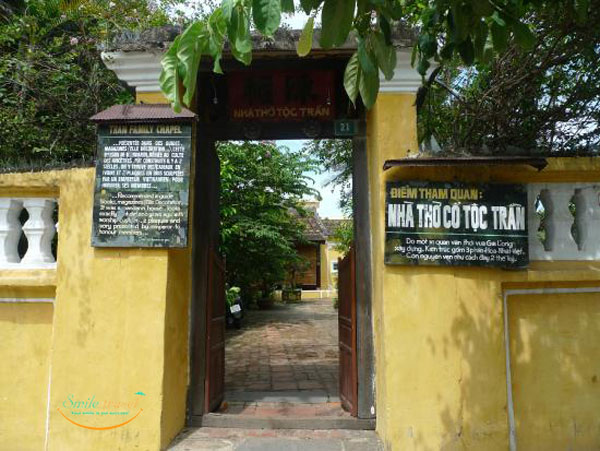
Tran’s Family Chapel
No one has the courage to state which exact place in Hoi An is the most ancient and beautiful, but many people know the Tran Family Chapel is one of the oldest and most historic houses in this city, dated back to the beginning of 19th century. This was built by Tran Tu Nhac – a highly-respected mandarin under Gia Long Reign before he was sent to China as the King’s envoys. Originally, it serves as a worshipping place for the family’s ancestors, as well as a reminder about the family’s tradition to the following generations. Today, tourists can find this famous must-see attraction in the old town Hoi An, at 21 Le Loi Street.
-
Hoian Museum of Ceramics
The Museum of Trade Ceramics in Hoi An, located at 80 Tran Phu Street, was opened in 1975. The museum keeps the track record of the history and the origins of this port town.
The building that serves as a museum itself is a very beautiful building constructed in the traditional Vietnamese architectural style. It is a two-story building with a courtyard and an anteroom – all of which are open to the public. Though the town of Hoi An is currently a fishing town, it once used to be a trade hub. Either way, the sea continues to play a major role in the life of the people of Hoi An. In the early days, when Hoi An was called Fai Fo, the chief article of trade to and from the town consisted mainly of pottery and, as such, pottery from different nations, including Chinese, Thai and Japanese, has been discovered.
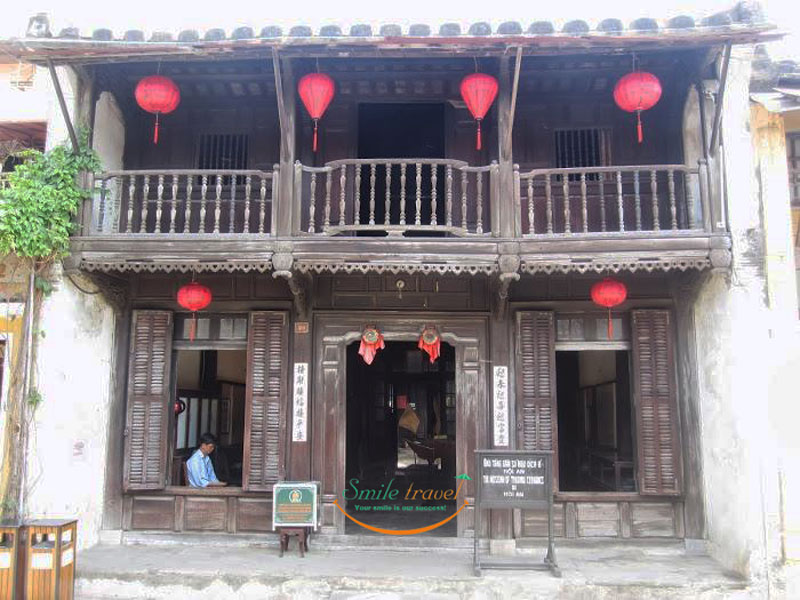
Hoian Museum of Ceramics
There are about 430 ceramic artifacts that stand as a testimony for the ceramic trade network dating back to the 8th to 18th centuries. Most of them come from Middle-East, India, China, Japan, Thailand and Vietnam. Among them, some antiques were picked up from a wrecked ship in the sea in 1733. Others were collected by archaeologists in the excavations carried out in the sites of Hoi An. They are the pottery of the Chinese Tang Dynasty (7th-10th centuries), of Middle East countries in the 7th-10th centuries and of Vietnam in the 15th century.
The museum is a precious material treasure that helps confirm the important role of Hoi An Trade Port in trading transactions, which had an immense influence on the economic and socio-cultural development of the town. Visitors are allowed to view the artifacts every day between 8:00 am and 5:00 pm.
-
Phuc Kien Assembly Hall
Phuoc Kien Assembly Hall, located at 46 Tran Phu Street, was founded in 1690 and served the largest Chinese ethnic group in Hoi An (the Fujian). It contains the Jinshang golden mountain temple and is dedicated to Thien Hau, the goddess of the sea and protector of the sailors. A pagoda is also a place of gathering for the natives of Phuoc Kien. You must visit this assembly hall to discover an excellent work of architecture, also considered a heritage of historical significance.
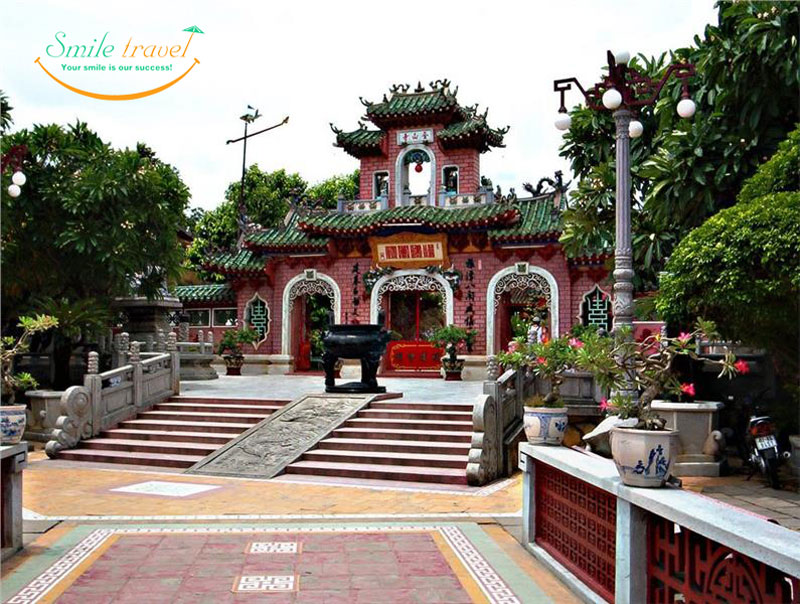
Phuc Kien Assembly Hall
Originally, the house was a thatched pagoda called Kim Son, which was built by Viet people living in Hoi An in 1692. The pagoda was dedicated to Buddha. Over the course of time, it was damaged, and in 1759 the owners had to sell it to the rich Phuoc Kien traders from China who came to Hoi An, so that it could be restored. After the restoration, the pagoda was renamed “Phuoc Kien Assembly Hall”.
Due to restorations and support by the Fukien people, the Assembly hall became resplendent and spacious, taking part in the embellishment of Hoi An’s architecture. Arranging the statues for worshiping means “human happiness”, and it profoundly expresses the oriental philosophy. The Assembly Hall is, in fact, a temple that holds the sea goddess Thien Hau, the goddess Thuan Phong Nhi, who is able to listen to the sound of a ship even at a distance of thousand miles, and at last the goddess Thien Ly Nhan, who is able to see those distant ships.
There are lots of animal symbols in the design and architecture of the Fukian Assembly Hall (Phuc Kien). The mosaic fountain inside the assembly hall bears a fish sculpture that is a symbol of achievement. Besides the fish, there are other animals such as dragon, unicorn, phoenix, turtle and so on. All these animals signify different features of Chinese culture. The dragon is the symbol of power and the turtle signifies endurance. On the other hand the unicorn is a symbol of knowledge and the phoenix represents nobility.
Phuoc Kien Assembly Hall is a religious relic. It is the biggest assembly hall and displays rich architectural and artistic features. Annually, on the 15th of January lunar year, 16th of February lunar year and 23rd of March lunar year many activities are organized, attracting a lot of foreign as well as domestic tourists. On the 17th of February 1990 Fukien has listed a national historical vestige.
-
Tan Ky Old House in Hoian
Tan Ky Old House, also known as Old House of Tan Ky, is an ingenious combination of 3 architectural styles, namely Vietnam, Japan, and China. The old house was built in the late-18th century with the first purpose of business, and agricultural product trade. Tan Ky Old House, the first old house in Hoi An Old Town together with Cau Pagoda and Fukian Assembly Hall was recognized as cultural-historical relics in 1985 by the Ministry of Culture. Despite undergoing many fluctuations, Tan Ky still retains almost intact values on architecture and culture.
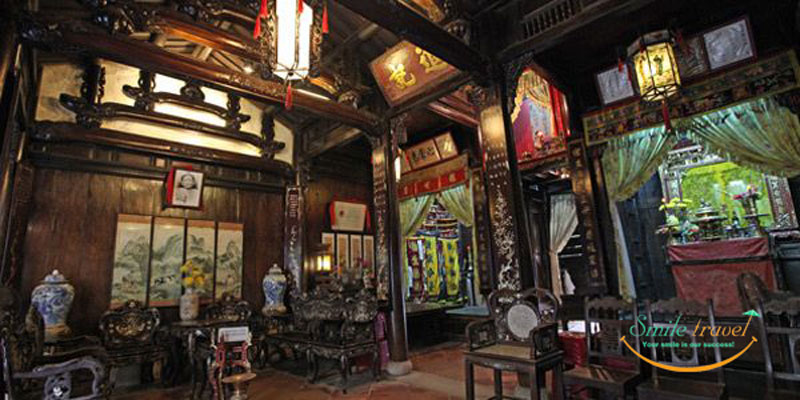
Tan Ky Old House in Hoian
Tan Ky Old House is still open to domestic and foreign tourists to visit daily. Stepping into the house, tourists will actually feel friendly and pleasant. The interior wood planks and the brick-built exterior make the house cool in summer and warm in winter. In addition, tourists also have a chance to be told about extremely valuable family heirlooms. They are “unique” antiquities and its story truly makes tourists astonished. Antiques to mention first are the cup of Confucius. When pouring water into the cup about 80%, the water level will have remained. However, if filling it, the water in the cup will flow out through a small hole at the bottom. The cup seems to be an ethics preachifying persons to restrain their own behavior and always keep their mind in balance, not excessiveness. Additionally, Tan Ky Old House is still home to numerous antiques, such as cups, plates, antique ceramic vases dating back hundreds of years. There is also
-
Hoian Museum of History & Culture
Containing a great number of historical relics, the Museum of History and Culture in Hoi An is located at 7 Nguyen Hue Street. The museum was set up in 1989, and the building used as a museum today is the former Pagoda,?Quan Yin?. The Museum of History and Culture in Hoi An was actually built as a religious establishment in the year 1635, and so it was set up accordingly.
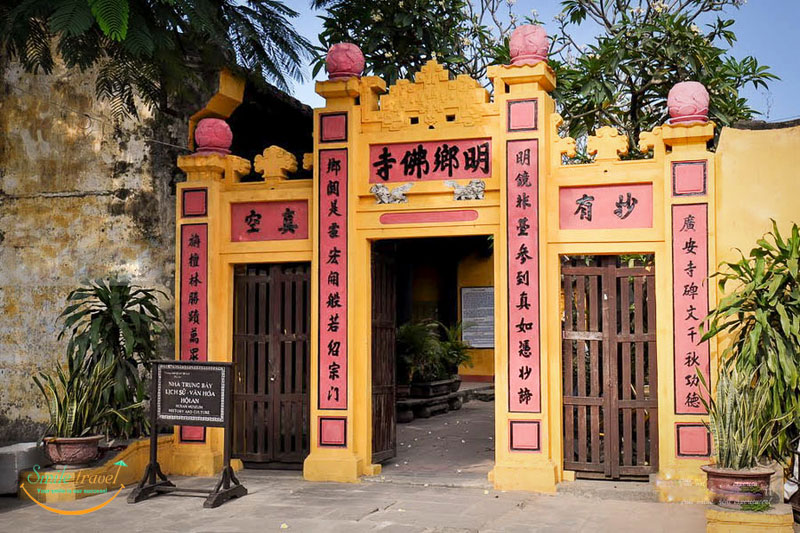
Hoian Museum of History & Culture
The museum contains 273 exhibits and documents concerning the formation and development of Hoi An. The exhibits include pottery, ceramics, bronze, iron, paper, wood and so on, and are classified into three periods: Prehistory, Cham Pa Period and Dai Viet Period. These phases correspond to Sa Huynh Culture (before 2nd century AD), Cham Pa Culture (2nd-15th century AD) and Dai Viet, Dai Nam Culture (16th-19th century) respectively. In the development process, Dai Viet is prominently highlighted as a bright period in the historical path of Vietnam. This treasure house is home to a potpourri of relics such as important photographs and maps, artifacts such as statues of different materials belonging to different civilizations, porcelain and ceramic wares, traditional scales, anchor, jar-burials from the Sa Huynh culture and family records that trace back the ancestry of the inhabitants. Also among the exhibits are bronze drums dating back to 3000 BC, the era of the Dong Son civilization.
The documents displayed here constitute a numerous and diverse cultural treasure that testifies the formation and development of Hoi An through the great creativity of many generations of local residents. This museum is almost like a show-and-tell summary of the entire heritage of Hoi An. So visiting other museums will benefit you more if you have gone to the Museum of History and Culture in Hoi An first.
Visiting Hoi An Historical Museum is also a chance for tourists to explore more interesting aspects about this land. For instance, the history of Tran Phu Street, the oldest street of Hoi An, the meaning behind the ?eyes’ on the doors of the ancient houses and the spiral carved patterns “De leaf”, “Yin and Yang”, and many others.
-
Hoian Folkore Museum
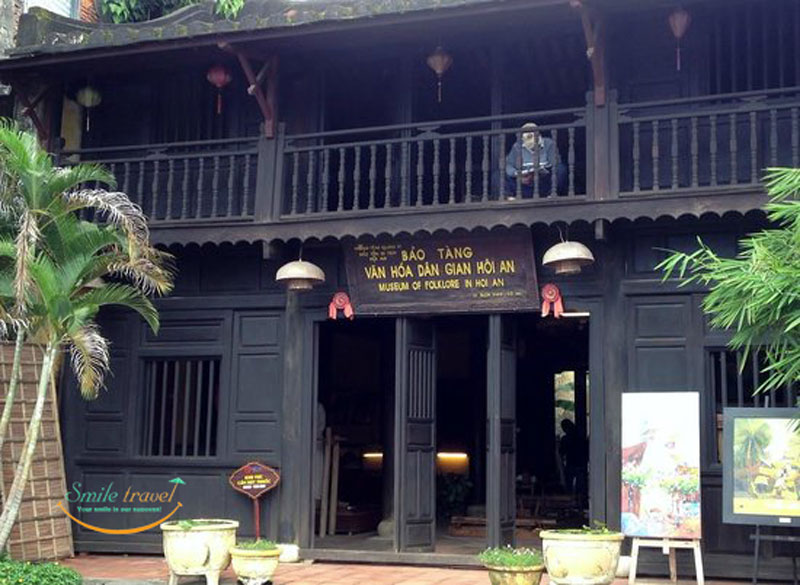
Museum of Folklore
This museum has collected over 600 objects, but only displays about 500 of them. 90% of these objects are original, sorted by topics: folklore, traditional occupation, traditional clothing, folklore games, etc. The exhibition is special as this is the first time such a collection of original objects has been displayed. All more than 100 years old, the objects depict the local daily life: Vietnamese family customs, Chinese family customs, songs and dances. This museum has made it possible for all these to be introduced to the public.
Tags:
Hoian, Tours in Hoian, What to see in Hoian, Must-See in Hoian, Hoian-Vietnam, Phung Hung Ancient House, Cantonese Assembly Hall, Tran’s Family Chapel, Hoian Museum of Ceramics, Phuc Kien Assembly Hall, Old House of Tam Ky, Hoian Museum of History & Culture, Hoian Folkore Museum…
Smile Travel is one of the fast growing Tour Companies in Vietnam. We are as Inbound and Outbound Tour Operator Licence No 01-1051/TCDL-GPLHQT. We specialize in tailor-making and customizing individual, Couple, family and group tours throughout Indochina destinations.
Our Tour:
Halong Cruises Tours, Vietnam Classic Tours, Hanoi Daily Tours, Danang Daily Tours, Ho Chi Minh Daily Tours, Biking and Motorbike Tours,Vietnam Beach/ Relaxing Tours,Vietnam Muslim tour in Hanoi,Vietnam Muslim tour in Danang ,Vietnam Muslim tour in Ho Chi Minh,Vietnam Eco Tours,Vietnam- Laos Tours,Vietnam- Cambodia Tours,Vietnam- Myanmar Tours,
Our Travel Services:
Tour Guide, Car/Motorbike For Rent, Visa to Vietnam, Bus Tickets, Bus Tickets, Flight Tickets, Train Tickets
--------------------------------------------------
